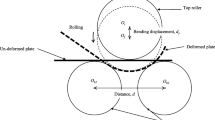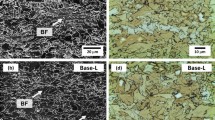Abstract
3-Roller bending is a widely applied manufacturing process, particularly in structural steel pipe industry. However, due to the difficulty and high cost of measuring stress distribution inside sheet material via traditional method, internal stress/strain response during forming is largely unexplored. The focuses of this study are two: (1) to map the radii of curvature as well as the stress inside the work piece during forming by utilizing the meshing mechanism of finite element method, and (2) to further provide some numeric guidelines for the configuration of the rolling system in order to improve production efficiency and product quality. The results of this study indicate that: (1) it is crucial to properly choose forming parameter in order to produce product with desired radii; (2) much like a gradual springback process, the radii of curvature gradually increase from the top roller to the exit-side bottom roller; (3) under the assumptions made in this study, to produce pipes with a specified diameter with varying configurations of the 3-roller system will not significantly change the final residual stress; and (4) finally, shifting of the neutral axis up to 2.0% of the thickness toward the compressing side during the forming process is observed.

















Similar content being viewed by others
Abbreviations
- U :
-
Y displacement of Roller 1 (top roller) between initial contact position and final rolling position (mm)
- A :
-
The X component of distance between Roller 2 (bottom front) and Roller 3 (bottom rear) (mm)
- S :
-
The X component of distance between Roller 1 and Roller 2 (mm)
- Si :
-
\(\frac{S}{A}\) (no unit)
- H :
-
Y component of distance between Roller 2 and Roller 3 (mm)
- R 1 :
-
Radius of Roller 1 (mm)
- R b :
-
Radius of Roller 2 and Roller 3 (mm)
- t :
-
Thickness of work piece (mm)
- µ :
-
Friction coefficient (no unit)
- V rel :
-
Relative speed between two contact surfaces when sliding (mm/s)
- FACT:
-
Ratio of static to dynamic coefficient of friction (no unit)
- DC:
-
Decay coefficient (no unit)
- r 0 :
-
Initial radii of curvature before springback (at point 1) (mm)
- r f :
-
Final radii of curvature after springback (after point 7) (mm)
- r u :
-
Upper limit of r 0 (mm)
- E :
-
Young’s modulus (MPa)
- K :
-
Strength coefficient (MPa)
- K′ :
-
\(K\left( {\frac{2}{\sqrt 3 }} \right)^{n + 1}\) (MPa)
- n :
-
Strain hardening exponent (no unit)
- v :
-
Poisson’s ratio (no unit)
- σ y :
-
Yield stress (MPa)
- \(\varepsilon_{\text{y}}\) :
-
Strain at yield point (no unit)
- D 0 :
-
\(2r_{0}\) (mm)
- D f :
-
2r f (mm)
References
M. Hua, D.H. Sansome, K. Baines, J. Mater. Process. Technol. 52, 425 (1995)
M.K. Chudasama, H.K. Raval, Int. J. Mater. Form. 6, 303 (2013)
M. Hua, I.M. Cole, K. Baines, K.P. Rao, J. Mater. Process. Technol. 67, 189 (1997)
A. Ktari, Z. Antar, N. Haddar, K. Elleuch, J. Mech. Sci. Technol. 26, 123 (2012)
A.H. Gandhi, H.K. Raval, J. Mater. Process. Technol. 197, 268 (2008)
Z. Feng, H. Champliaud, Simul. Model. Pract. Theory 19, 1913 (2011)
G. Van Boven, W. Chen, R. Rogge, Acta Mater. 55, 29 (2007)
R.A. Carneiro, R.C. Ratnapuli, V. de Freitas, Cunha Lins. Mater. Sci. Eng. A 357, 104 (2003)
R.N. Parkins, Corros. 2000, 1 (2000)
C.W. Choi, H.J. Koh, S. Lee, Metall. Mater. Trans. A 31, 2669 (2000)
ANSYS Inc., ANSYS Mechanical APDL Material Refence, Release 15.0, 27 (2013)
W.F. Hosford, R. Caddell, Metal Forming (Cambridge University Press, Cambridge, 2011)
C. Bouhelier, Formage des tôles fortes (TI, Paris, 1982)
S. Timoshenko, History of Strength of Materials: With a Brief Account of the History of Theory of Elasticity and Theory of Structures (Dover Publications, New York, 1953)
W. Johnson, P.B. Mellor, Engineering Plasticity (Halsted Press, New York, 1983)
J. Rondal, Constr. Build. Mater. 1, 150 (1987)
B. Goes, J. Gil-Sevillano, U. D′Haene, Int. J. Mech. Sci. 41, 1031 (1999)
Z. Marciniak, J.L. Duncan, S.J. Hu, Mechanics of Sheet Metal Forming (Butterworth-Heinemann, Oxford, 2002)
Acknowledgements
The authors would like to acknowledge the financial support provided by the LSU Graduate School through the Economic Development Award. The working knowledge provided by Dr. Kompotiatis of the STUPP Corporation is most valuable to this study.
Author information
Authors and Affiliations
Corresponding author
Additional information
Available online at http://link.springer.com/journal/40195
Rights and permissions
About this article
Cite this article
Zhao, W., Warren Liao, T. & Kompotiatis, L. Stress and Springback Analyses of API X70 Pipeline Steel Under 3-Roller Bending via Finite Element Method. Acta Metall. Sin. (Engl. Lett.) 30, 470–482 (2017). https://doi.org/10.1007/s40195-016-0527-6
Received:
Revised:
Published:
Issue Date:
DOI: https://doi.org/10.1007/s40195-016-0527-6




